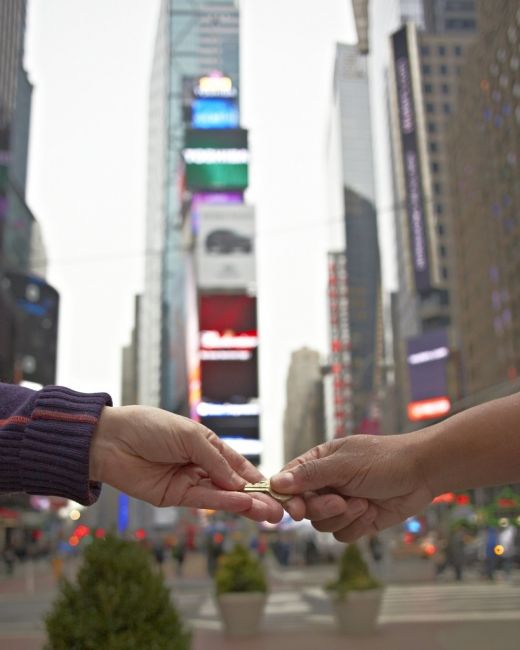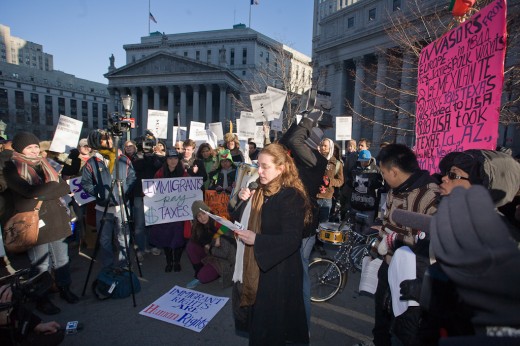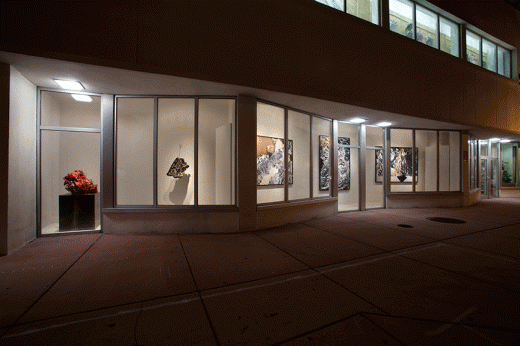
Paul Ramírez Jonas, Key to the City, Manhattan, 2010. Photograph by Paul Ramírez Jonas, Courtesy Creative Time.
HUNTER BRAITHWAITE (RAIL): Since you both lead institutions of a different caliber, I was wondering if you could speak to perceived roles and obligations of institutions when it comes to funding and supporting public art. Furthermore, how have these developed in recent history, and how is our moment different from earlier times?
ANNE PASTERNAK: Wow. That’s a big question that can hardly be dealt with in a short interview. However, let me start by clarifying for your readers that both of our organizations are non-profit and we both have to raise money from public and private sources. As you point out, things have changed over recent years. Creative Time emerged 40 years ago, at a time in which the government felt strongly that supporting the arts would prove to the world that we were not an unsophisticated, war-like nation. Rather, it would show that democracy worked and that artists could speak freely, even when that meant speaking out against the government. This was a central premise of the creation of the NEA and state arts agencies. I could go on and on about this history and its implications, successes, and failures. But let me just say that due to the right-wing assault on artists during the culture wars, public funding for contemporary art and grants to individual artists eroded. Many foundations followed suit, and fear, leading to funder and institutional self-censorship, began to flourish. More and more cultural institutions took a more conservative programming approach.
Of course there are exceptions, but this is by and large the reality. The decline in public and major foundation support coincided with an increase in individual wealth in this country. Smart organizations went to where the money is—rich people who love culture. And thank goodness for them. They do so much good in investing in great ideas, the expansion of programs and buildings, and so much more. I’m wowed by the great intentions and actions everywhere around this country—I often think we are unique not only in having a tax structure that benefits those who can give back, but by the vast philanthropic drives of people throughout this country. However, it is also important to recognize that the greater reliance on wealthy individuals brings new challenges in terms of donor influence over programming. Again and again, my colleagues confide that they feel their vision is restricted as they are fearful of offending major supporters. I believe this is having huge implications on the social relevance of our institutions, especially as global digital networks, access to travel, and the globalization of art markets expose us to new geopolitical realities, realities that might not be in harmony with the personal viewpoints of individual supporters. The things that are essential to our missions and relevance as public institutions—taking on challenging issues, being places for free expression, hosting respectful debate—are at stake. And it’s serious.

Tania Bruguera, Immigrant Movement International, Queens, 2011. Photo courtesy Creative Time. Photo by Sam Horine.
Miami, on the other hand, is a teenage city that is trying very hard and very fast to be an adult. In many ways it succeeds, but in other ways, Miami needs more time. In many cases, the founders are still involved running our institutions or sitting on the boards. Board seats cannot rotate as often as is healthy for institutions because Miami is still developing a civic and philanthropic community and has very few—but increasingly more—of what I call our heroes, people who work very hard to support organizations in this challenging fundraising landscape. In the last ten years, Miami’s organizations have grown and professionalized enormously. Although I appreciate Anne pointing out the existing implications the sources of funding have on institutions and individual artists, in Miami, the challenge regarding censorship, both in public art and art within walls of institutions, is more about the censorship of what simply cannot exist, happen, be presented or commissioned. Period. As a city, I guess we are still building platforms for expression, physically and figuratively. This is a colossal and unruly task that leaves little room for much else. In this uncertain terrain, however, there is a great sense of freedom, creativity and possibility.
RAIL: Public art institutions relying on the benevolence of personal donors is a sensitive situation. Can either of you give a specific example of your organization successfully navigating a tricky project without alienating your donor base?
PASTERNAK: Not really, sorry. I’m not being cagey but none come to mind. With that said, I can tell you that while the Occupy movement was in full force the fall of 2011, I was posting on my Facebook account some articles about education, climate and the economy that I found particularly interesting. Because the articles came from Occupy, more than one donor shared their discomfort over my posts. They warned me to be careful as I was threatening to alienate our donor base. I continued to post articles from and about Occupy, and I do think it affected some of our individual funding.
CUBIÑÁ: When I began at the Bass Museum four years ago, we developed a curatorial vision that included more emphasis on contemporary art and the integration of contemporary art with old masters from our collection. I did not know our membership and I was not sure how our museum community would react or if we would lose members or what. Well, we lost some members, I received a couple of unhappy letters and a few complaints at the front desk, but in four years our membership has increased by 60 percent and our budget has doubled.
RAIL: What about the end result? Are there any specific goals that you and your organization have when it comes to presenting public art?
PASTERNAK: Each project has its own goals. But we are always motivated by the same three primary values: that artists should experiment and in so doing push their practice and our field forward, that public spaces should be place for free and creative expression, and that artists should be weighing in on the times in which we live.
RAIL: Public spaces should be a place for free and creative expression, but that’s not often the case. To get back to what you said about the right’s erosion of the NEA during the culture wars…
PASTERNAK: …Yes they should be spaces for free expression, and by principle and law they are. We need to push back against the growing trend of limiting our speech in public.
CUBIÑÁ: Tc: temporary contemporary has as its tagline “art in unexpected places.” Miami is not a city with an established museum-visiting culture. It is just not yet built into people’s lifestyles or psyches. Museum attendance is generally event driven, so the Bass Museum sees Miami Beach, our most pedestrian-friendly city, as a great opportunity to move art out of its building and into the public realm, so people can happen upon it while they go about their daily lives. That is the goal: tc wants to insert art into people’s day to day comings and goings.
RAIL: Silvia, one of the pieces I saw during this Basel was Cristina Lei Rodriguez’s “Store Windows (Walgreens, South Beach),” in which the artist installed her work and a performer in a storefront window on Collins Avenue. However, the fact that this occurred during Basel stands out to me. “Day to day” means year-round, but most of the public projects in this city are centered around the first week of December.

Cristina Lei Rodriguez, Store Windows (Walgreens, South Beach), 2012, site-specific installation. Photo courtesy of the artist and Fredric Snitzer Gallery, Miami. Photo by Silvia Ros.
RAIL: Public art is often used as a tool for social renewal and gentrification. In Miami, we have seen this in the Design District and Wynwood, and New York has seen it most recently with the High Line. By extension, those working with public art, either in a creative or administrative role, could be seen as interested in community development. Is this an unfair assumption?
PASTERNAK: It is true that more and more artists engage communities, and that more and more government agencies and private developers are using art as a tool for gentrification. For the record, arts incorporation into the High Line was not part of an effort to gentrify the neighborhood, though I can’t say it didn’t contribute to it. I wonder how often these actions actually contribute to gentrification. I think it’s important to recognize that there are many facets to gentrification. There are the terrible realities of pricing people out of neighborhoods where they have long resided, and pushing them further to the fringes of urban areas. This is horrible for the individuals, their families, and the community. It undermines the essential importance of diversity—racial, cultural, economic—of our cities. I know my colleagues will be annoyed with me, but I also have to say I have thoughtfully listened to pro-revitalization arguments and I am sympathetic to urban planners who rightly point to the importance of renewing neighborhoods, providing jobs, safe places to work and gather, learn, share, and live. This is a moment of more nuanced debate in this area, and it’s important that artists and arts presenters are at the table with urban planners, developers, and government officials to make sure that the integrity of community is preserved while a neighborhood is being revitalized. At Creative Time, we are very sensitive to these issues and think about them deeply. They factor into how we make decisions about where we work, or do not work. And they factor into how we engage a community.
CUBIÑÁ: I always get nervous when art is at the service of something else: gentrification, mental health, math test scores, etc. This is too much responsibility for art and artists. Art was at the forefront of developing neighborhoods like SoHo and Miami’s Design District, certainly. I was in the Design District for seven years, where we founded the Moore Space, which received rent-free space for seven years. Artists were given studios for free and restaurants were given storefronts for free so we could all have lunch. We all got together and came up with a gallery night, lectures, performances, etc. Craig Robins, the main developer, and the art collector and donor Rosa de la Cruz were working in dialogue with the community to make this all happen. They listened to artists and responded to what the community wanted and needed and they supported these efforts very generously. Gentrification came slowly and much later.
This was ten years ago. Since then, the real-estate reality in Miami has changed drastically. So, getting back to why I get nervous. I get nervous when areas, or even streets, in development start gallery walks, produce art festivals or declare themselves art neighborhoods and there are no artists or art; I get nervous when creative energy is managed or institutionalized as part of a strategy or program. It’s the cart before the horse. Artists seek out a place for its freedom and cheap rent. They do not necessarily need or want art walks, neighborhood associations, marketing efforts or PR strategies.
RAIL: Having worked with many artists undertaking public projects, I wonder if you could give any insight into the differences between creating for the public sphere and creating for the gallery, or a more traditional setting. Of course questions of budgets and logistics arise, but does conflating the individual viewer with a public audience change anything about a given piece?
PASTERNAK: Well, first, there can be practical issues working in the public sphere. At Creative Time, we are invested in removing the many barriers to creativity that artists face in realizing their projects. In the gallery, one would hope the artist has complete freedom to share their work, though that’s hardly a rule. But in general, it’s easier. The gallery or curator selects some works and they get installed in the gallery. Before you can show work in the public sphere, you often bump up against laws, government and community relations, and the complexities around messaging for diverse audiences, to name just a few real challenges. But artists don’t want to only speak to people like themselves. They want all sorts of people to experience their work and engage in its meaning and relevancy. The rich responses of the public audiences, untainted by the rigors of the art world, never cease to amaze me.
CUBIÑÁ: Adding to Anne’s lists of challenges, we have hurricane and turtle issues to deal with!
RAIL: Oh my. So, with today’s spatial parameters shifting to include the Internet, the corporate plazas and semi-public parks central to the Occupy movement, could you provide a working definition of the space in which art can truly be public?
CUBIÑÁ: With tc: temporary contemporary, we’ve had a lot of fun exploring what public space really means in Miami Beach. Take August for example, it is hot, sticky, and there are mosquitos. Public space is not really a park or street corner during that time of year. We installed Marco Brambilla’s “RPM,” his video commissioned by Ferrari, at a gas station a block away from the museum. Increasingly, commercial and private spaces are wonderful public spaces: a coffee shop, a store, and a hotel lobby. I once worked with the artist Pepon Osorio on a public project called “Home Visits” where one sculpture went into a private home in a housing project in Puerto Rico, an unlikely setting for a work of art. The work was on loan to the resident for a period of time and thereafter, the sculpture moved from home to home, reflecting and somewhat inverting larger art world issues of inaccessibility. Our definition of public space is fluid and ongoing and I like it this way.
RAIL: Going off the last question, have you noticed any trends today that might hint at where public art will reside in the coming decades?
PASTERNAK: Artists don’t like their practices to be put in neat little boxes, so I am wary of misrepresenting practices by discussing them in terms of trends. What I can say is that I am very intrigued by the growing number of artists in the US and around the globe who consider the ways they engage in social justice or community engagement. Our brilliant chief Curator, Nato Thompson, has written a lot about this and we produced a challenging traveling exhibition and useful book, Living as Form, that raises awareness about what we refer to as “social practice” art and elevates the complexities of creating this kind of work—from its aesthetic implications to issues of geopolitical realities and dynamics of race and class. Fundamental to this work is the question of what is art. I find it difficult, challenging, and utterly thrilling.










